
Chapter 3
Native culture of Antigua, Guatemala
The next day was a long drive from Copan to Antigua — luckily on a new luxurious bus that made us all feel much more comfortable. We stopped for lunch in Guatemala City, the capital of Guatemala, and walked through the National Palace. The beautiful stained glass windows portraying events in Mayan history are gradually being replaced after being destroyed in the bombing during the last revolution (1995). It’s a beautiful palace — complete with a one ton French chandelier in the grand receiving room — but I found the market area in front of the building more interesting. The Guatemalan fabrics are fantastic.

Women wear the native costumes — most men have adopted more contemporary clothes, mostly because of their service in the military.
After checking into our Antigua hotel we toured the city and learned a bit about Guatemala. There are three volcanoes around Antigua and 37 in the whole country (four are still considered active). The area is prone to earthquakes — there were four last year. The last one was 6.3 for 60 seconds. Most families have about 8 children and the population has grown from 3 to 11 or 12 million is the last 30 years. There are 3 million people in Guatemala City (the capital) but they’re not real sure of the total population since many people refused to answer the last census taken by the new government in 1996. One out of ten children go to school — most are needed to work for their family. A farm laborer makes about $3 a day. Over-population and illiteracy are big problems, especially since there are 26 indigenous languages, and too many children grow up without learning Spanish
Antigua is the city where the huge sculptures from the cathedral are paraded on people carried floats at Easter — on elaborate "carpets" made of colored sawdust. In our tour of Antigua we stopped to watch some men who were restoring some of the paintings from the cathedral.
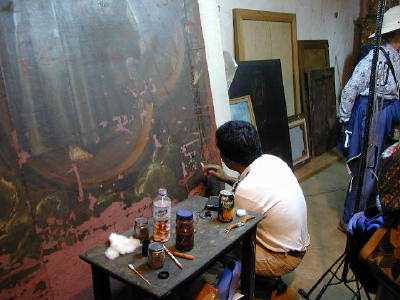
We also stopped at a weaving "parlor" where the women from the hills bring in their cloth to trade for more thread and a few dollars (Quesales, actually — 7.6 to the dollar).
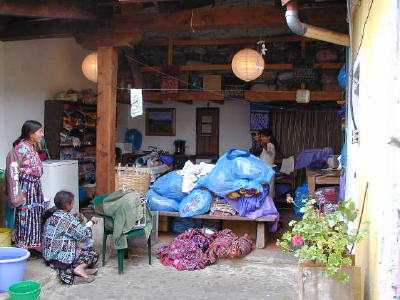
Jade has been produced in this area since Mayan times and we watched gem crafters at the jade factory. Then a tour of one of the local mansions — colonial and modern mansions all seem to be squares around enclosed plaza.
Our evening’s "lecture" was a religious ceremony by a local woman "guide" (medicine woman) who is one of the women consulted by the hill people when they are ill or have some other difficulty. The religion is based on nature and oriented to compass directions (north, south, east and west). It is still rather secretive, although the Catholic Church has finally recognized and incorporated the Mayan traditions. They have been practiced in secret for centuries, which is how the Mayas have continued their traditions and folklore. According to one of our lecturers, the merging of religions is called "scyncronism" and is why many Mayan and Catholic holidays are celebrated together.
The next morning we had a fascinating display of Mayan weaving. The back loom is hooked on a tree or post someplace and then a strap goes behind the woman’s back so that she can control the tension with her body angle.
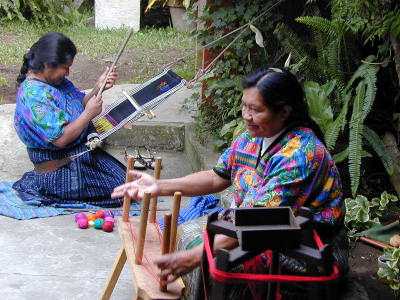
They create beautiful designs without patterns — it all comes out of their head. Amazing.
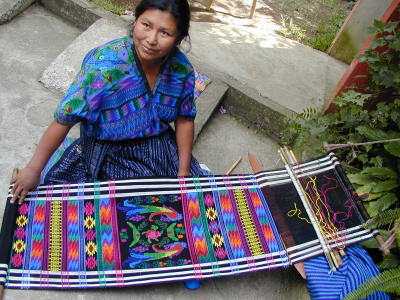
Two of our group got to dress in traditional Guatemalan wedding finery — we all enjoyed their display.
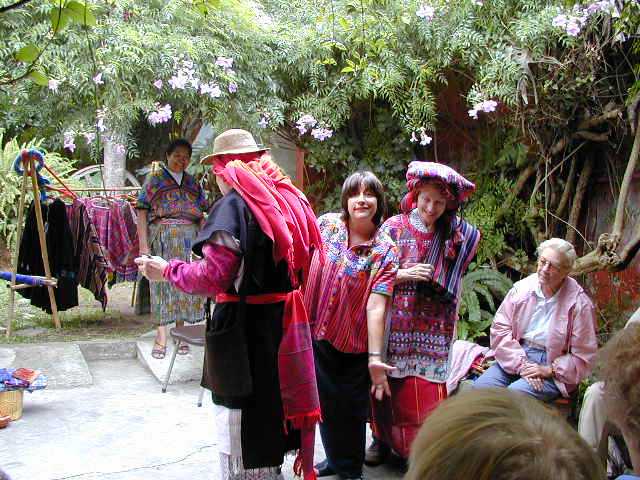
The evening lecture on agriculture pointed up one of Guatemala’s major problems. Enough arable land to feed all the people is difficult to find, and usually is exhausted after a few years. They still use the slash and burn system in many areas and plant with a sharp stick, three seeds in each hole — a corn, bean, and squash seed. Three crops from each acre. Now many of the colder lands (mountains) are used to grow other vegetables.
We also had an interesting presentation of the music of the Mayas — percussion (Tum is a slit drum) and flutes were the only early music producers, mostly for ceremonial occasions. The Spaniards brought the guitar and the harp and African slaves brought the marimba heritage. They have all been incorporated in the modern Guatemalan music.